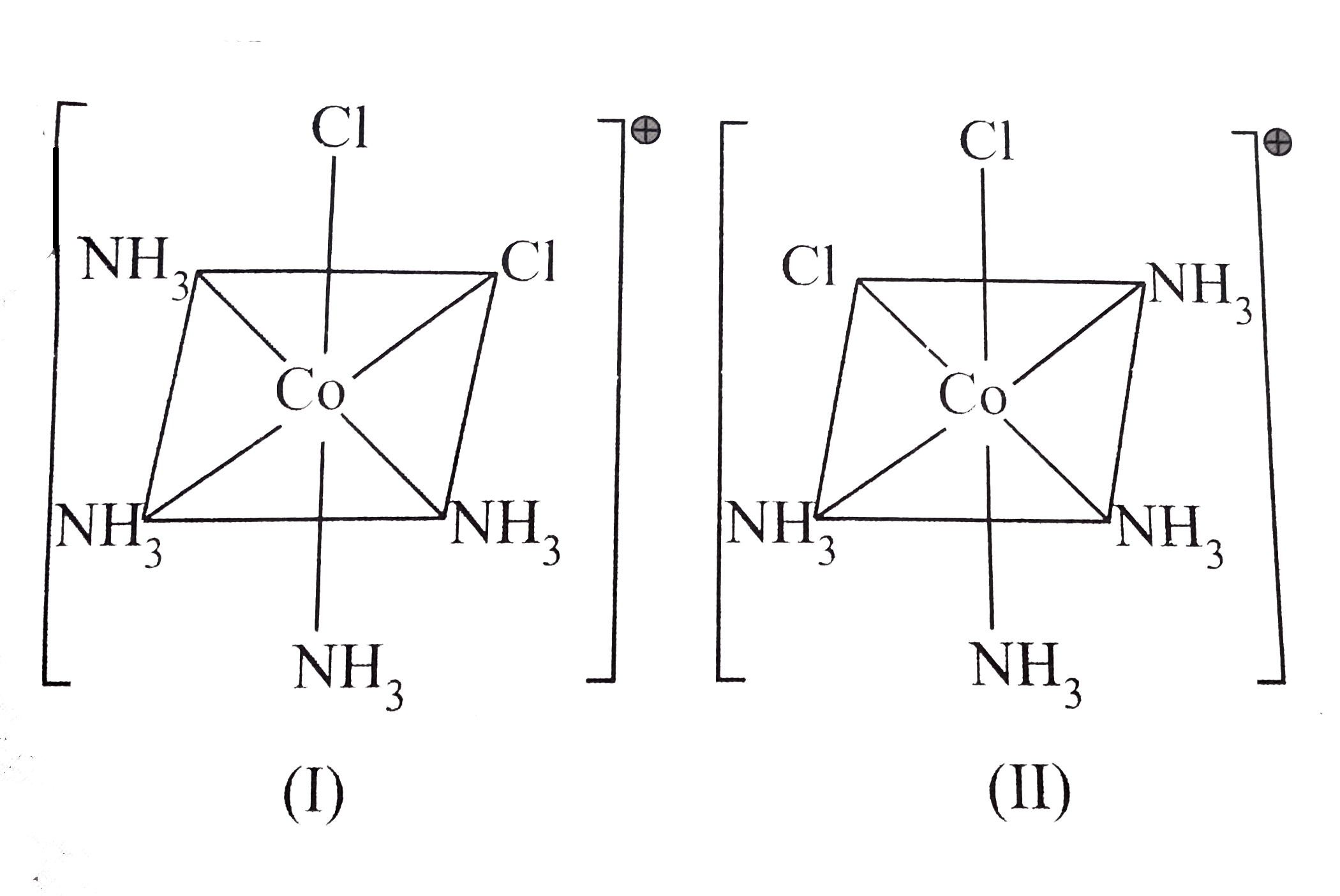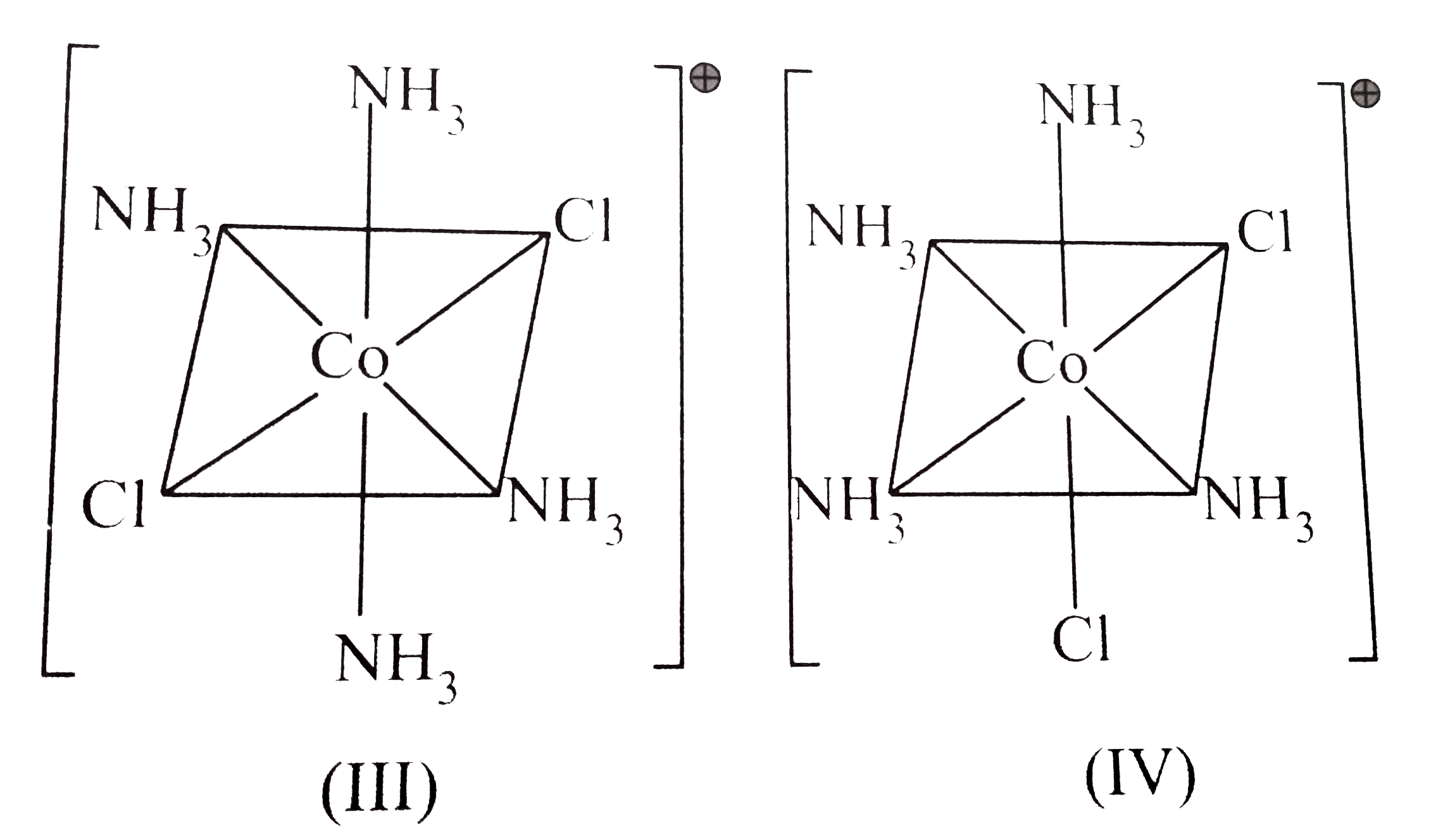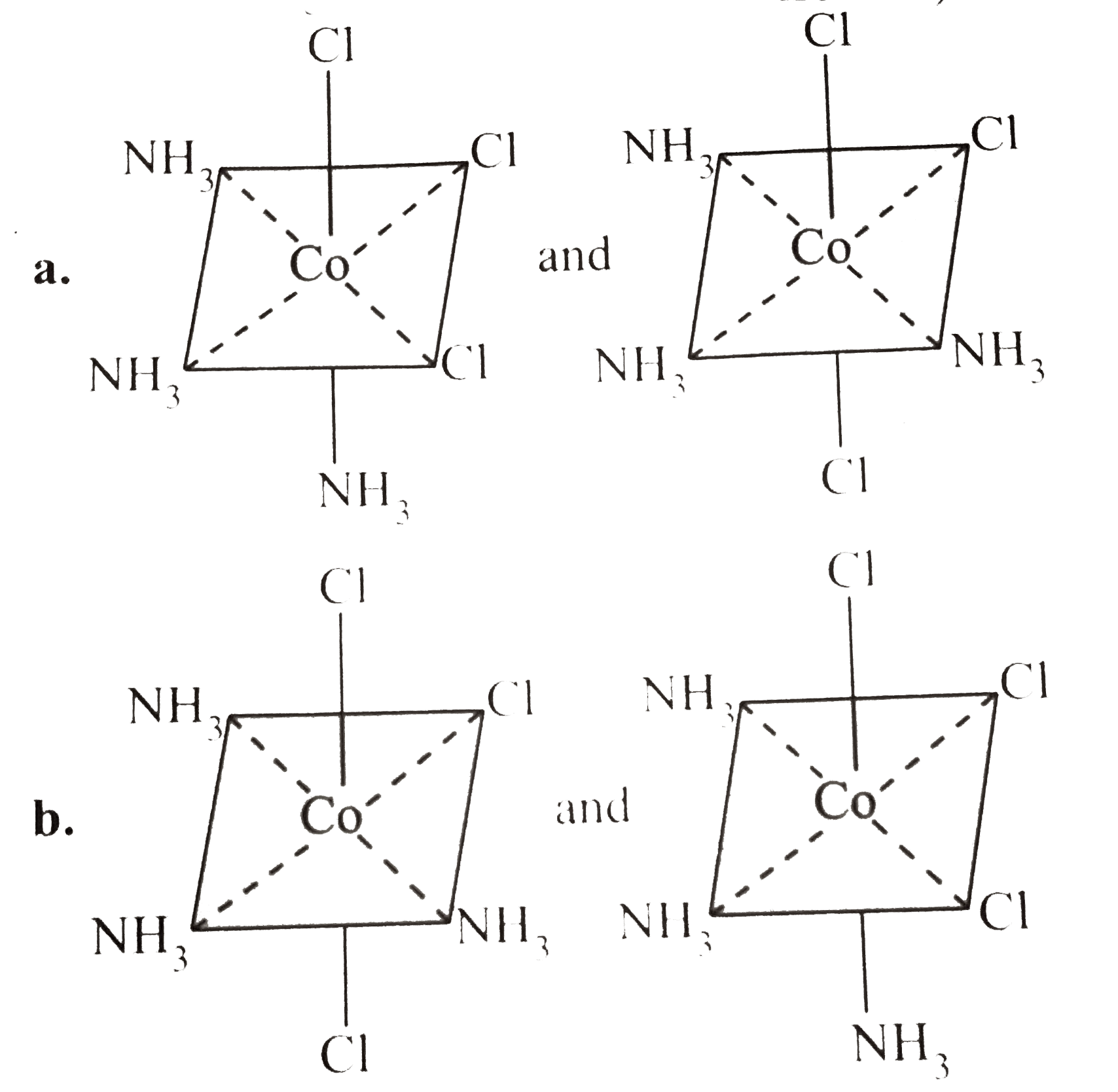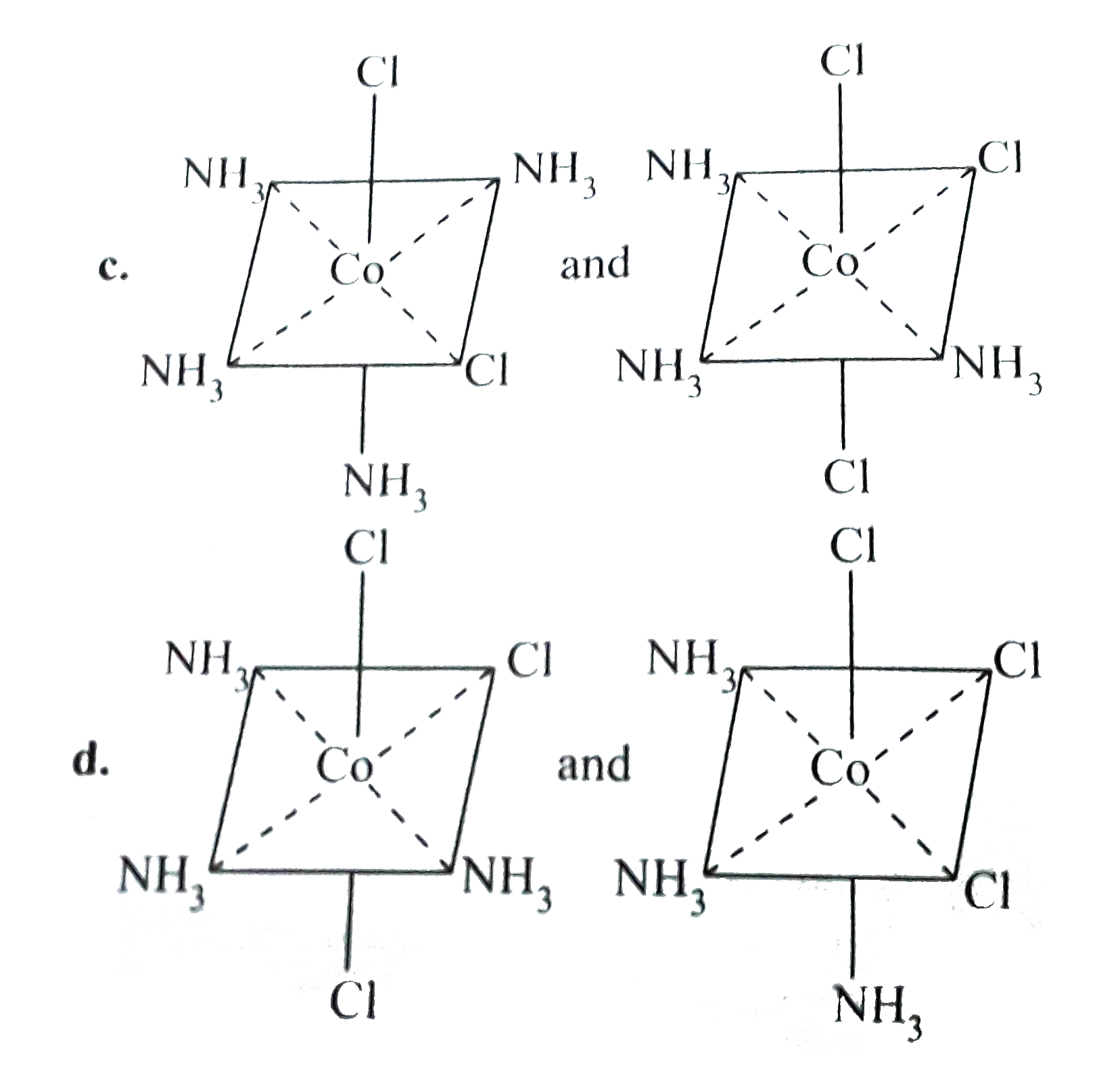Complete Solutions to Ex 7.1 Objective (Isomerism) of chapter COORDINATION COMPOUNDS of Class 12 book with complete answers and questions
| Class 12 | CHEMISTRY |
| Chapter | COORDINATION COMPOUNDS |
| CENGAGE CHEMISTRY | Ex 7.1 Objective (Isomerism) |
| Number Of Questions | 12 |
| Academic Year | 2023-24 |
Which of the following coordination compounds exhibits ionisation isomerism
(a) `[Cr(NH_(3))_(6)]CI_(3)`
(b) `[Cr(en)_(3)CI_(3)]`
(c ) `[Cr(en)_(3)]CI_(3)`
(d) `[Co(NH_(3))_(5)Br]SO_(4)` .01:43View SolutionWhich of the following complex compounds exhibits cis-trans isomerism
(a) `[PtCI_(2)(NH_(3))_(2)]`
(b) `[PdCI_(2)BrI]`
(c ) `[Pt(NH_(3))(py)(CI)(Br)]`
All ofh these .03:43View SolutionHow many geometrical isomers are possible for the square planar complex `[Pt(NO_(2))(py)(NH_(3))(NH_(2)OH)]NO_(2)`
(a) `Four
(b) Five
(c ) Eight
(d) Three .02:18View SolutionConsider the following spatial arrangements of the octahedral complex ion `[Co(NH_(3))_(4)CI_(2)]^(o+)`


Which of the following statements is incorrect regarding these structures?03:36View SolutionWhich of the following pairs of structures represent facial and meridional isomers (geometrical isomers) respectively ?

 .03:44View Solution
.03:44View SolutionWhich would exhibit coordination isomerism
`[Cr(NH_(3))_(6)][Co(CN)_(6)]`
(b) `[Cr(en)_(2)CI_(2)]^(o+)`
(c ) `[Cr(NH_(3))_(6)]CI_(3)`
`[Cr(edta)]^(-1)` .01:42View SolutionWhich would exhibit ionisation isomerism
(a) `p[Co(NH_(3))_(6)][(C_(2)O_(4))_(3)]`
(b) `[Co(NH_(3))_(5)Br]^(2+)SO_(4)^(2-)`
(c ) `K_(3)[Fe(CN)_(6)]`
`K_(3)[Fe(C_(2)O_(4))_(3)]` .01:58View SolutionThe water -soluble complex among the following is
(a) `[Ni(HDMG)_(2)]`
(b) `[Co(NH_(3))_(3)CI_(3)]`
(c ) `Ni(CO)_(4)`
`[Ni(HDMG)_(2)]CI_(2)` .01:55View SolutionArrage the following optical activity possible in
(a) `[Co(H_(2)O)_(2)(NH_(3))_(3)CI]^(o+)`
(b) `[Co(H_(2)O))_(4)CI_(2)]^(o+)]`
(c ) `[Co(NH_(3))_(4)(NO_(2))CI]^(o+)`
(d) `[Co(CN)_(5)NC]^(Θ)` .02:10View SolutionWhen an excess of ammonia solution is added to `CuSO_(4)` which solution is formed
(a) `[Cu(NH_(3))_(2)]^(2+)`
(b) `[Cu(NH_(3))_(4)]^(o+)`
(c ) `[Cu(NH_(3))_(2)]^(o+)`
(d) `[Cu(NH_(3))_(4)]^(2+)` .01:14View SolutionCopper sulphate solution reacts with `KCN` to give
(a) `Cu(CN)_(2)`
(b) `CuCN`
(c ) `K_(2)[Cu(CN)_(4)]`
(d) `K_(3)[Cu(CN)_(4)]` .01:38View SolutionThe ionisation isomer of `[Co(H_(2)O)_(4)CI_(2)NO`
(a) `[Co(H_(2)O)_(4)(NO_(2))]CI_(2)`
(b) `[Co(H_(2)O)_(4)CI_(2)]NO_(2)`
`[Co(H_(2)O)_(4)CI(ONO)]CI`
(d )`[Co(H_(2)O)_(4)CI_(2)(NO_(2))]H_(2)O` .02:08View Solution
Ex 7.1 Objective (Isomerism) questions and complete solutions for chapter COORDINATION COMPOUNDS of CENGAGE CHEMISTRY (HINGLISH) of Class 12
All Exercises from CENGAGE CHEMISTRY Class 12 CHEMISTRY COORDINATION COMPOUNDS
- Archives (Linked Comprehension)
- Archives Assertion Reasoning
- Archives Fill The Blanks
- Archives Integer
- Archives Multiple Correct
- Archives Single Correct
- Archives Subjective
- Archives True/False
- Ex 7.1 Objective (Isomerism)
- Ex 7.1 Objective (Terminology)
- Ex 7.1 Subjective (Conductance In Coordination Compounds)
- Ex 7.1 Subjective (Effective Atomic Number (Ean))
- Ex 7.1 Subjective (Isomerism In Coordination Compounds)
- Ex 7.1 Subjective (Terminology)
- Ex 7.2 Objective
- Ex 7.2 Subjective
- Exercises Assertion Reasoning
- Exercises Fill The Blanks
- Exercises Integer (Hybridisation , Vbt , Cft And Application)
- Exercises Integer (Isomerism)
- Exercises Integer (Naming And Terminology)
- Exercises Linked Comprehension
- Exercises Multiple Correct (Hybridisation , Vbt , Cft )
- Exercises Multiple Correct(Application Of Coordination Compounds)
- Exercises Multiple Correct(Isomerism )
- Exercises Multiple Correct(Naming And Terminology)
- Exercises Single Correct (Application Of Coordination Compounds And Miscellaneous)
- Exercises Single Correct (Crystal Field Theory (Cft))
- Exercises Single Correct (Hybridisation , Magnetic And Optical Properties )
- Exercises Single Correct (Isomerism)
- Exercises Single Correct (Naming And Terminology)
- Exercises True/False
- Illustration
- Solved Examples
